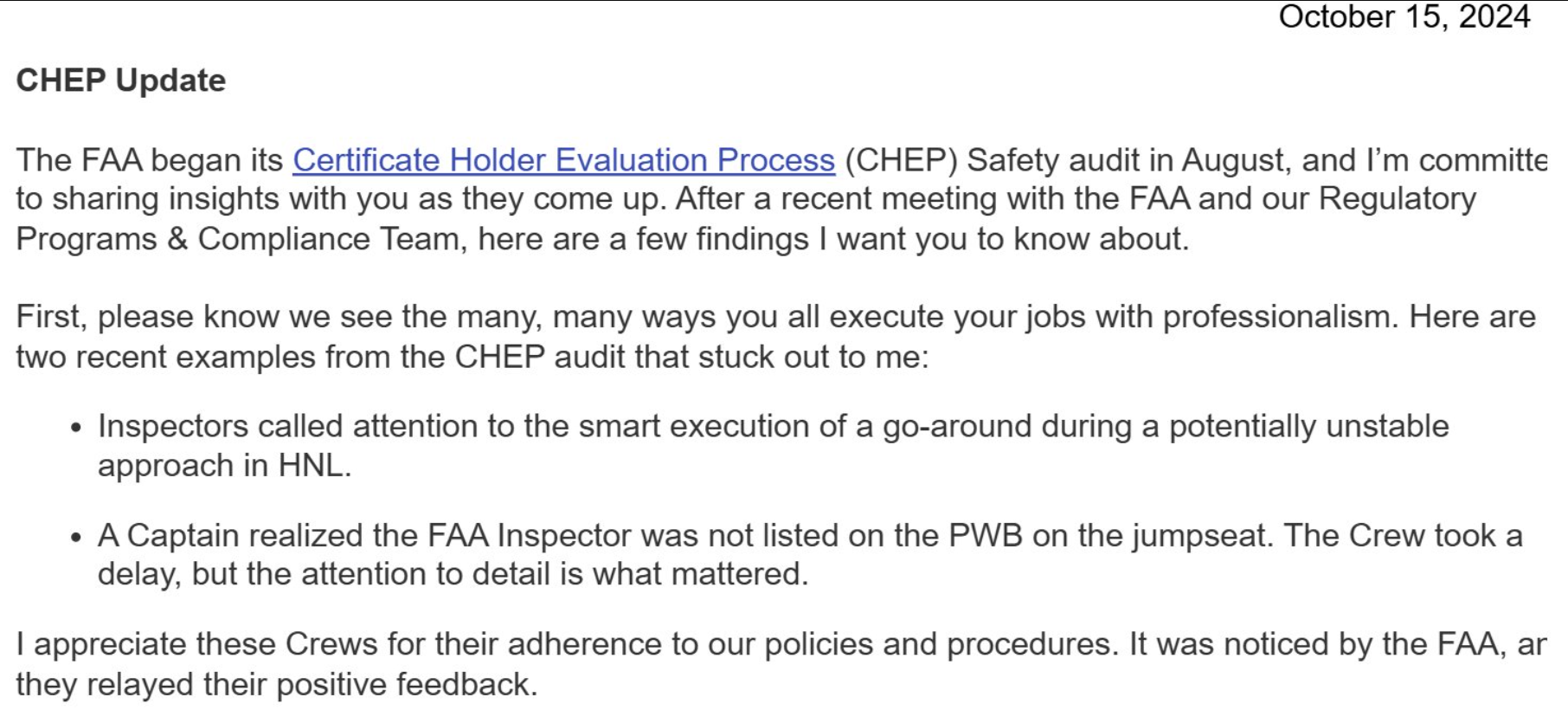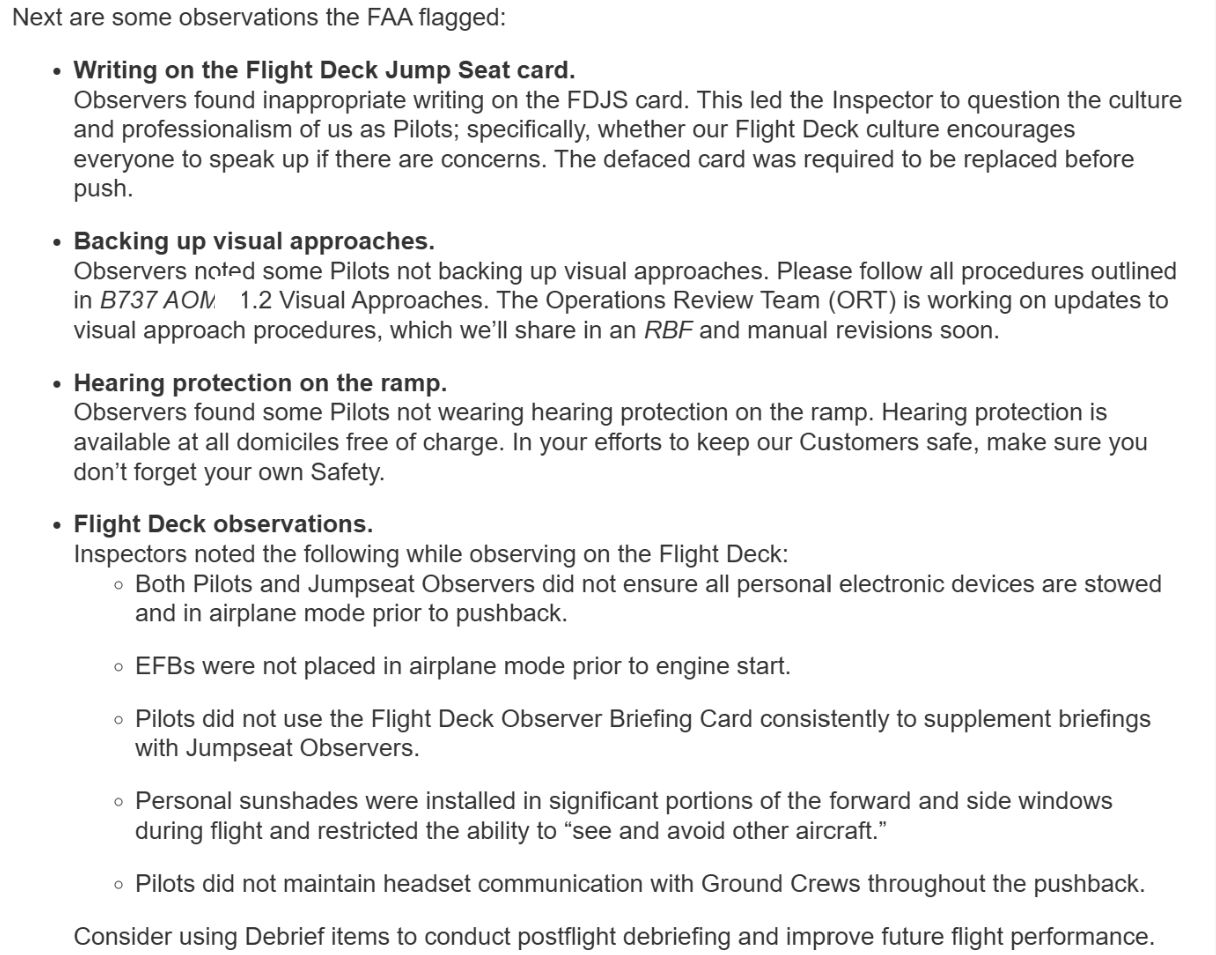Over the summer the FAA launched a safety audit of Southwest Airlines. This came after the airline came within feet of the water while still miles from Tampa less than a month after another of the airline’s 737s descended to just over 500 feet while still 9 miles out from the Oklahoma City airport.
In April, a Southwest Airlines flight in Hawaii came within 400 feet of the Pacific Ocean. Then in June a Southwest Airlines flight took off from a closed runway
Southwest has shared internally some of the issues that FAA inspectors have flagged during the Certificate Holder Evaluation Process Safety Audit.


I suppose some of these are better than the pilots who spent a flight watching video feed of passengers in the lavatory?
The airline declined comment since “[t]he CHEP is still underway” except to say that the airline “proactively shares safety information such as this with Employees as part of its Safety Management System.”
The FAA’s Office of Inspector General has previously found that the agency “has not effectively overseen Southwest Airlines’ systems for managing safety risks.”
FAA learned in 2018 that the carrier regularly and frequently communicated incorrect aircraft weight and balance data to its pilots—a violation of FAA regulations and an important safety issue. Southwest Airlines also operates aircraft in an unknown airworthiness state, including more than 150,000 flights on previously owned aircraft that did not meet U.S. aviation standards—putting 17.2 million passengers at risk.
In both cases, the carrier continues operating aircraft without ensuring compliance with regulations because FAA accepted the air carrier’s justification that the issues identified were low safety risks.
Second, FAA inspectors do not evaluate air carrier risk assessments or safety culture as part of their oversight of Southwest Airlines’ SMS. This is because FAA has not provided inspectors with guidance on how to review risk assessments or how to evaluate and oversee a carrier’s safety culture. As a result, FAA cannot provide assurance that the carrier operates at the highest degree of safety in the public’s interest, as required by law.
Since the start of the pandemic, the FAA ‘closed’ 9 of 11 recommendations to address deficiencies in monitoring Southwest Airlines safety. However five years later there are still outstanding items that the FAA has agreed are problems but have not been fixed.
United has just come out from under a safety audit, with the FAA announcing that it found no significant issues. Air traffic control, though, may be the current most critical vulnerability.


Nice article, Gary ! Your two introductory paragraphs highlight the four incidents which are top of mind for most of us, the preliminary FAA findings were a nothingburger compared to those. No doubt the FAA review will get around to those eventually, until then, nothing to see here !
I want to know what happened last year in LGA with the multiple go arounds and the tower fly by.
Yes yes ! That one too, @Coffee Please !
UA had a number of issues that were due to diverse causes – but they have managed to tighten them all up which is why the FAA couldn’t find anything system.
WN’s issues have been very similar which made it certain the FAA would find things w/ the pilot culture.
WN has been lucky that none of these incidents ended up the way they could have.
Add in that WN is facing all kinds of business issues and the company is at a crossroads.
Hopefully the pilots understand that WN needs to change and it is not just management that needs ot change.
This article is about southwest, yet the picture by the headline is of a pilot in an Airbus. SW has no Airbus. I know, this guy is anal on detail.
@Tim: Where do you find the information about ‘tightem them all up’? I think there were just no significant findings.
Your beloved Delta also had a couple of not so shiny moments.
first, the FAA isn’t interested in a “couple of” moments – they look for a string of incidents. UA had wheels fall off of planes, near ditching (not unlike WN), taxiway excursions, and some seriously bent metal. Doesn’t matter what you think happened at anyone else… the FAA invested UA and the big news had a pretty steady diet of UA stories for a number of months. UA sent out some nastygrams to its employees and the FAA found no discernible patterns.
We get that you love to hypocritically “but there are buggers in your nose too” but the FAA hasn’t investigated any airlines other than UA and WN.
This is not current or accurate. Agents of the FAA over Cabin Safety assisted on the Part 5 CHEP Audit and were heavily involved in SWA’s SMS program as well they continue to routinely evaluate and approve their SMS program.
Oh please. The “lavatory camera” incident was a captain who’d once filmed himself in the lav, and would then leave the video playing anytime he actually had to leave the flight deck, so that FA’s who’d come up to guard the door would see it playing. He’d then have the FO say, “Shhh, don’t tell anyone about our super-secret, post-9/11 lavatory cameras.”
It was a joke, the company investigated, and the judge laughed her lawsuit out of court.
Guy in the photo is not only in the wrong model aircraft, he is in the left seat, but only has three stripes!